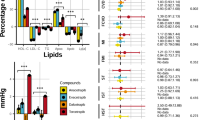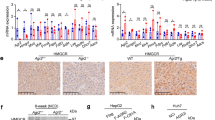Abstract
Cholesteryl ester transfer protein (CETP) is a plasma protein that mediates the exchange of cholesteryl ester in high-density lipoprotein (HDL) for triglyceride in very low density lipoprotein (VLDL)1,2. This process decreases the level of anti-atherogenic HDL cholesterol and increases pro-atherogenic VLDL and low density lipoprotein (LDL) cholesterol, so CETP is potentially atherogenic3,4,5,6,7,8,9. On the other hand, CETP could also be anti-atherogenic10,11,12,13,14, because it participates in reverse cholesterol transport (transfer of cholesterol from peripheral cells through the plasma to the liver)15. Because the role of CETP in atherosclerosis remains unclear, we have attempted to develop a potent and specific CETP inhibitor. Here we describe CETP inhibitors that form a disulphide bond with CETP, and present one such inhibitor (JTT-705) that increases HDL cholesterol, decreases non-HDL cholesterol and inhibits the progression of atherosclerosis in rabbits. Our findings indicate that CETP may be atherogenic in vivo and that JTT-705 may be a potential anti-atherogenic drug.
This is a preview of subscription content, access via your institution
Access options
Subscribe to this journal
Receive 51 print issues and online access
$199.00 per year
only $3.90 per issue
Buy this article
- Purchase on Springer Link
- Instant access to full article PDF
Prices may be subject to local taxes which are calculated during checkout




Similar content being viewed by others
References
Tall, A. R. Plasma cholesterol ester transfer protein. J. Lipid. Res. 34, 1255–1274 (1993).
Lagrost, L. Regulation of cholesteryl ester transfer protein (CETP) activity: review of in vitro and in vivo studies. Biochem. Biophys. Acta. 1215, 209–236 (1994).
Brown, M. L. et al. Molecular basis of lipid transfer protein deficiency in a family with increased high-density lipoproteins. Nature 342, 448–451 (1989).
Marotti, K. R. et al. Severe atherosclerosis in transgenic mice expressing simian cholesteryl ester transfer protein. Nature 364, 73–75 (1993).
Quinet, E., Tall, A. R., Ramakrishnan, R. & Rudel, L. Plasma lipid transfer protein as a determinant of the atherogenicity of monkey plasma lipoproteins. J. Clin. Invest. 87, 1559–1566 (1991).
Bhatnagar, D. et al. Increased transfer of cholesteryl esters from high density lipoproteins to low density and very low density lipoproteins in patients with angiographic evidence of coronary artery disease. Atherosclerosis 98, 25–32 ( 1993).
Foger, B., Luef, G. & Ritsch, A. Relationship of high-density lipoprotein subfractions and cholesteryl ester transfer protein in plasma to carotid artery wall thickness. J. Mol. Med. 73, 369–372 (1995).
Sugano, M. et al. Effect of antisense oligonucleotides against cholesteryl ester transfer protein on the development of atherosclerosis in cholesterol-fed rabbits. J. Biol. Chem. 273, 5033– 5036 (1998).
Herrera, V. L. et al. Spontaneous combined hyperlipidemia, coronary heart disease and decreased survival in Dahl salt-sensitive hypertensive rats transgenic for human cholesteryl ester transfer protein. Nature Med. 5, 1383–1389 (1999).
Bruce, C., Chouinard, R. A. Jr & Tall, A. R. Plasma lipid transfer proteins, high-density lipoproteins, and reverse cholesterol transport. Annu. Rev. Nutr. 18, 297–330 (1998).
Fielding, C. J. & Havel, R. J. Cholesteryl ester transfer proteins: friend or foe? J. Clin. Invest. 97, 2687–2688 (1996).
Hayek, T., Masucci-Magoulas, L. & Jiang, X. Decreased early atherosclerotic lesions in hypertriglyceridemic mice expressing cholesteryl ester transfer protein transgene. J. Clin. Invest. 96, 2071–2074 (1995).
Zhong, S. et al. Increased coronary heart disease in Japanese-American men with mutation in the cholesteryl ester transfer protein gene despite increased HDL levels. J. Clin. Invest. 97, 2917– 2923 (1996).
Foger, B. et al. Cholesteryl ester transfer protein corrects dysfunctional high density lipoproteins and reduces aortic atherosclerosis in lecithin cholesterol acyltransferase transgenic mice. J. Biol. Chem. 274 , 36912–36920 (1999).
Fielding, C. J. & Fielding, P. E. Molecular physiology of reverse cholesterol transport. J. Lipid Res. 36, 211–228 (1995).
Connolly, D. T., Heuvelman, D. & Glenn, K. Inactivation of cholesteryl ester transfer protein by cysteine modification. Biochem. Biophys. Res. Commun. 223, 42–47 (1996).
Morton, R. E. & Zilversmit, D. B. Inter-relationship of lipid transferred by the lipid-transfer protein isolated from human lipoprotein-deficient plasma. J. Biol. Chem. 258, 11751– 11757 (1983).
Frank, D. et al. Hypercholesterolemia in the rabbit induced by feeding graded amounts of low-level cholesterol: methodological considerations regarding individual variability in response to dietary cholesterol and development of lesion type. Artherioscler. Thromb. Vasc. Biol. 16, 1454–1464 (1996).
Whitlock, M. E. et al. Monoclonal antibody inhibition of cholesteryl ester transfer protein activity in the rabbit. Effects on lipoprotein composition and high density lipoprotein cholesteryl ester metabolism. J. Clin. Invest. 84, 129–137 ( 1989).
Inazu, A. et al. Increased high-density lipoprotein levels caused by a common cholesteryl-ester transfer protein gene mutation. N. Engl. J. Med. 323, 1234–1238 ( 1990).
Wilson, P. W. F., Abbot, R. D. & Castelli, W. P. High density lipoprotein cholesterol and mortality. The Framingham Heart Study. Arteriosclerosis. 8, 737–741 (1988).
Oram, J. F. & Yokoyama, S. Apoprotein-mediated removal of cellular cholesterol and phospholipids. J. Lipid. Res. 37, 2473–2491 (1996).
Mackness, M. I. & Durrington, P. N. HDL, its enzymes and its potential to influence lipid peroxidation. Atherosclerosis. 115, 243–253 ( 1995).
Suc, I., Escargueil-Blanc, I., Troy, M., Salvayre, R. & Negre-Salvayre, A. HDL and ApoA prevent cell death of endothelial cells induced by oxidized LDL. Arterioscler. Thromb. Vasc. Biol. 17, 2158–2166 (1997).
Kunkel, T. A. Rapid and efficient site-specific mutagenesis without phenotypic selection. Proc. Natl Acad. Sci. USA 82, 488– 492 (1985).
Tollefson, J. H. & Albers, J. J. Isolation, characterization, and assay of plasma lipid transfer protein. Methods Enzymol. 129, 797–816 (1986).
Chiba, H. et al. Quantitative and compositional changes in high density lipoprotein subclasses in patients with various genotypes of cholesteryl ester transfer protein deficiency. J. Lipid Res. 38, 1204 –1216 (1997).
Gerdes, L. U., Gerdes, C., Klausen, I. C. & Faergeman, O. Generation of analytic plasma lipoprotein profiles using two prepacked Superose 6B columns. Clin. Clim. Acta 205, 1– 9 (1992).
Acknowledgements
We thank Y. Iwamoto, M. Maki and T. Sotani for their assistance with the experiments, and A. Mizushima and M. Kamada for advice. We also thank H. Koizumi and the staff of the Toxicology Research Laboratories at the Central Pharmaceutical Research Institute of JT Inc.
Author information
Authors and Affiliations
Corresponding author
Rights and permissions
About this article
Cite this article
Okamoto, H., Yonemori, F., Wakitani, K. et al. A cholesteryl ester transfer protein inhibitor attenuates atherosclerosis in rabbits. Nature 406, 203–207 (2000). https://doi.org/10.1038/35018119
Received:
Accepted:
Issue Date:
DOI: https://doi.org/10.1038/35018119
This article is cited by
-
Proteomics Analysis of Lipid Metabolism and Inflammatory Response in the Liver of Rabbits fed on a High Cholesterol Diet
Cell Biochemistry and Biophysics (2023)
-
CETP Inhibitors: Should We Continue to Pursue This Pathway?
Current Atherosclerosis Reports (2022)
-
Epistatic interactions of genetic loci associated with age-related macular degeneration
Scientific Reports (2021)
-
Alterations of lipid metabolism, blood pressure and fatty liver in spontaneously hypertensive rats transgenic for human cholesteryl ester transfer protein
Hypertension Research (2020)
-
Lack of association between FTO gene variations and metabolic healthy obese (MHO) phenotype: Tehran Cardio-metabolic Genetic Study (TCGS)
Eating and Weight Disorders - Studies on Anorexia, Bulimia and Obesity (2020)
Comments
By submitting a comment you agree to abide by our Terms and Community Guidelines. If you find something abusive or that does not comply with our terms or guidelines please flag it as inappropriate.



